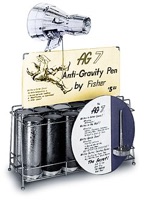ASK Sales Representing The Finest Manufactures
Fisher Space Pen
ASK Sales Representing The Finest Manufactures
Fisher Space Pen

Conceived in a dream in July 1948, Paul Fisher was soon machining a new pen design shaped from solid aluminum. It became our first Fisher ball point pen, the #400 Chrome Bullet Pen, and arguably the most popular pen of the twentieth century.
Cited as an outstanding example of industrial art, the classic design of the Fisher Bullet Pen has been exhibited for years in the New York Museum of Modern Art. The Bullet's timeless styling has been the topic of many art books and magazine articles. Often imitated but never duplicated, the Fisher Bullet continues to be our most popular pen.

Unlike ordinary ball pens which rely on gravity to feed ink, the Space Pen’s replaceable cartridge is pressurized. At nearly 50 pounds per square inch, ink is continuously fed to the tungsten carbide ball, allowing the user to write at any angle, even upside down. This advancement required the development of a special ink.

The new visco-elastic ink, with a consistency similar to that of very thick rubber cement, flows as a result of the shearing action of the rolling ball in its socket.. This shearing action liquifies the solid gel thixotropic ink, allowing the pen to write smoothly and dependably on most surfaces and even under water.
Evaporation, wasted ink and back leakage are eliminated. Shelf-life is increased to an estimated 100 years.


In the 1950's there were dozens of ballpoint models, and nearly every one took a different cartridge. In 1953 Fisher invented the "Universal Refill" which could be used in most pens. It was a good seller, since stationery store owners could reduce their stock of assorted refills.
Not content, Fisher continued to work on making a better refill. After much experimentation he perfected a refill using thixotropic ink-semisolid until the shearing action of the rolling ball liquefied it-that would flow only when needed. The cartridge was pressurized with nitrogen so that it didn't rely on gravity to make it work. It was dependable in freezing cold and desert heat. It could also write underwater and upside down. The trick was to have the ink flow when you wanted it to, and not to flow the rest of the time, a problem Fisher solved. Fisher's development couldn't have come at a more opportune time. The space race was on, and the astronauts involved in the Mercury and Gemini missions had been using pencils to take notes in space since standard ball points did not work in zero gravity. The Fisher cartridge did work in the weightlessness of outer space and the astronauts, beginning with the October, 1968 Apollo 7 mission began using the Fisher AG-7 Space Pen and cartridge developed in 1966.
For more information visit the Fisher Space Pen web site.
Retailer Information Request Form
If you are a retailer located in northern California or N. Nevada and which more information on this product please submit your request by Email below. Specify either “Send product literature” or “Have a salesperson contact you” in the subject line.
Last Updated: August 11, 2019 By Info@ASKSales.com

